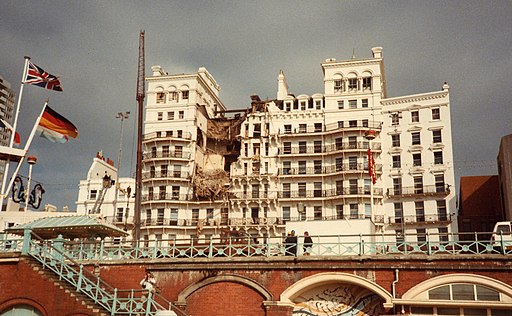Every January the British National Archives prompt a flurry of historical recollections and reflections when they release a tranche of previoulsy confidential government documents under the “thirty-year rule”.
This year, 1984 comes under the spotlight, a year in which the most significant event as far as Ireland is concerned was the IRA’s bombing of the Brighton hotel where the Conservative Party was holding its annual conference. The attack came very close to killing Prime Minister Margaret Thatcher.
The Cabinet documents now available show how the attack almost derailed moves towards a rapprochement between the British and Irish governments. Earlier the same year the Cabinet had discussed whether, and in what ways, the Irish government could aid in dealing with the Troubles in Northern Ireland.
In particular, the rise of Sinn Féin as a political force on the back on the Hunger Strikes and continuing terrorist violence meant that all options were open for consideration. Most sensationally, it has been revealed that plans to redraw the border were discussed at the highest level.
Redrawing the border?
Basing their proposals on research by Dr Paul Compton, an academic at Queen’s University Belfast, officials at the Northern Ireland Office suggested the size of Northern Ireland could be reduced by as much as half. If the lines were drawn carefully, the analysis said, around 500,000 Catholics (and therefore presumed Nationalists) would have found themselves in the Republic of Ireland, leaving Northern Ireland with a much larger Protestant majority.
The areas proposed for transfer included parts of Fermanagh, south Armagh and most of the city of Derry/Londonderry. The most radical — and, let’s face it, most impractical — suggestion was making (nationalist) West Belfast a walled enclave of the Republic, presumably on the model of West Berlin!
The whole episode recalls that other “what-if” of Northern Ireland’s history, the 1925 Border Commission, which also looked into the possibility of altering the border to move predominantly Catholic areas into the Free State.1
It’s an indication of the seriousness of the situation at the time that these ideas were seriously looked into. It’s also no wonder that they were kept secret, given the reaction of Unionists to something comparably minor such as talks with taoiseach Garret Fitzgerald’s government. On the latter issue, the British were aware that although “any British initiative on Northern Ireland was likely to raise unjustified expectations and fears in the Province and thereby make matters worse, the present situation there was so bad that it would be wrong not to explore the possibilities for change. The consequences of doing nothing could be as damaging in terms of continued loss of life as the consequences of seeking a new approach”.2 The Cabinet was sceptical that talks with the Irish would bring any concrete results (no chance was envisaged of getting Articles 2 and 3 of the Irish Constitution3 removed or changed, for example) but concluded that an approach to their counterparts across the water was “the least unpromising way forward”.4 A coordinated approach to policing and steps to reconcile the nationalist population in the North to Northern Ireland’s existence were marked as points to be raised in negotiations.
The Brighton Bombing
These tentative moves towards each other almost ended after the IRA Brighton bombing on 12 October, in which five people were killed and many more injured and crippled.
In an indication of how counter-productive such attacks were, Thatcher noted that “we must go very slow on these talks, if not stop them. It would look as if we were bombed into making concessions to the Republic.”5The following month Thatcher and Fitzgerald met but agreed on very little. Irish proposals for “joint authority” over Northern Ireland were rejected outright, while comments made by the taoiseach for the benefit of his home audience were considered by the British to have “soured the atmosphere of Anglo-Irish relations”.6
The year seemed to end on a gloomy note, with the Cabinet minutes for 29 November 1984 noting that “the Unionists were devoting more time and energy to rejoicing over what they regarded as a successful outcome to the Anglo-Irish Summit7 than to addressing the political problems which Northern Ireland faced” and that the Irish government “was still resentful after its failure to secure arrangements for the exercise of joint authority”.8
It’s all the more remarkable, then, that the Anglo-Irish Agreement was signed by the two Premiers only a year later. But we’ll have to wait till 2015 to find out what really happened behind the scenes in 1985.
- You can read more about the Border Commission and what happened to its recommendations in the Irish History Compressed e-book. ↩
- http://filestore.nationalarchives.gov.uk/documents/cab-128-80.pdf, page 10 ↩
- These laid claim to the territory of Northern Ireland. ↩
- http://filestore.nationalarchives.gov.uk/documents/cab-128-80.pdf, page 10 ↩
- http://filestore.nationalarchives.gov.uk/documents/prem-19-1288.pdf, p. 150 ↩
- http://filestore.nationalarchives.gov.uk/documents/cab-128-80.pdf, page 17 ↩
- i.e. that it had achieved nothing. ↩
- http://filestore.nationalarchives.gov.uk/documents/cab-128-79.pdf, page 229 ↩


